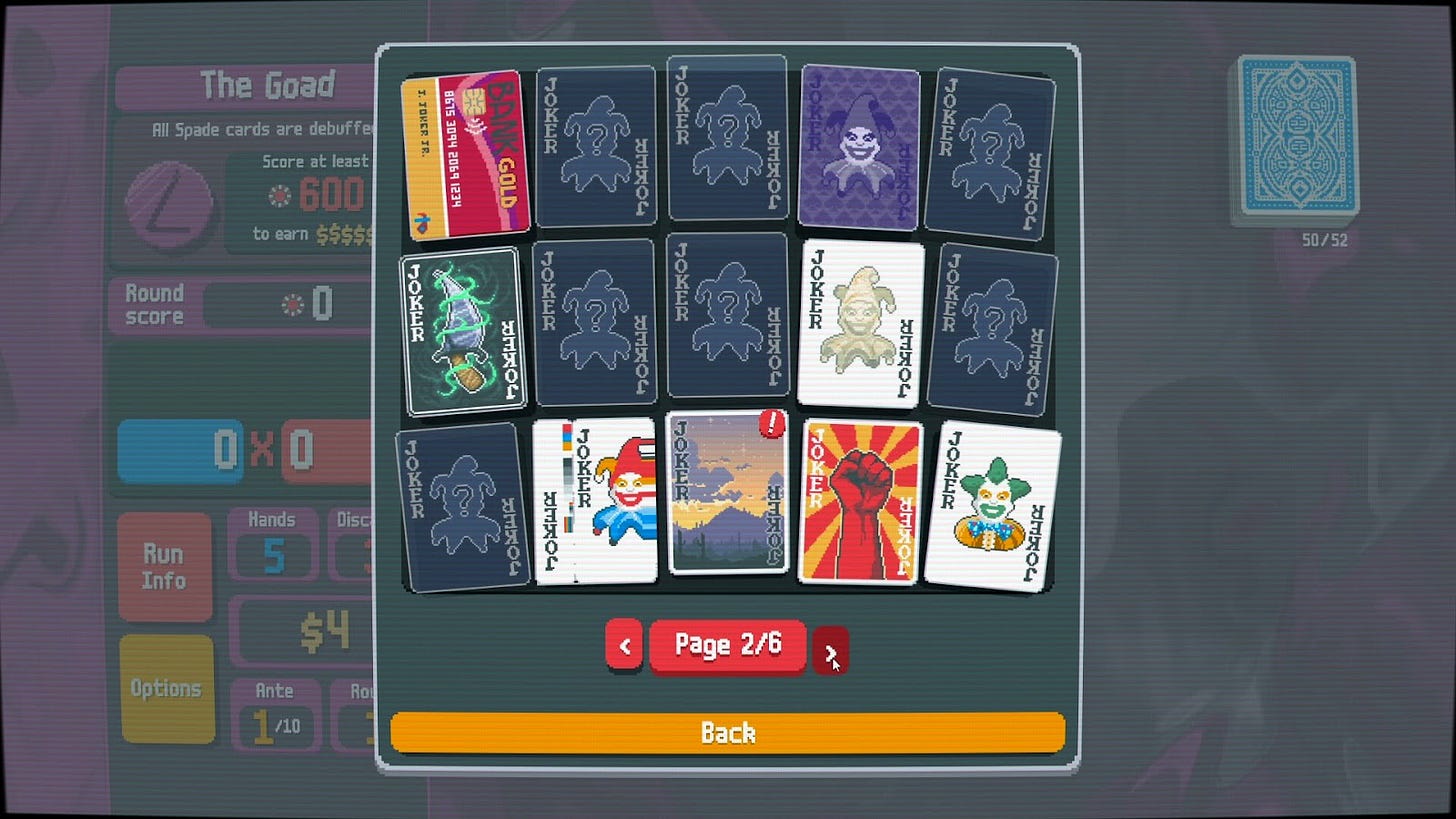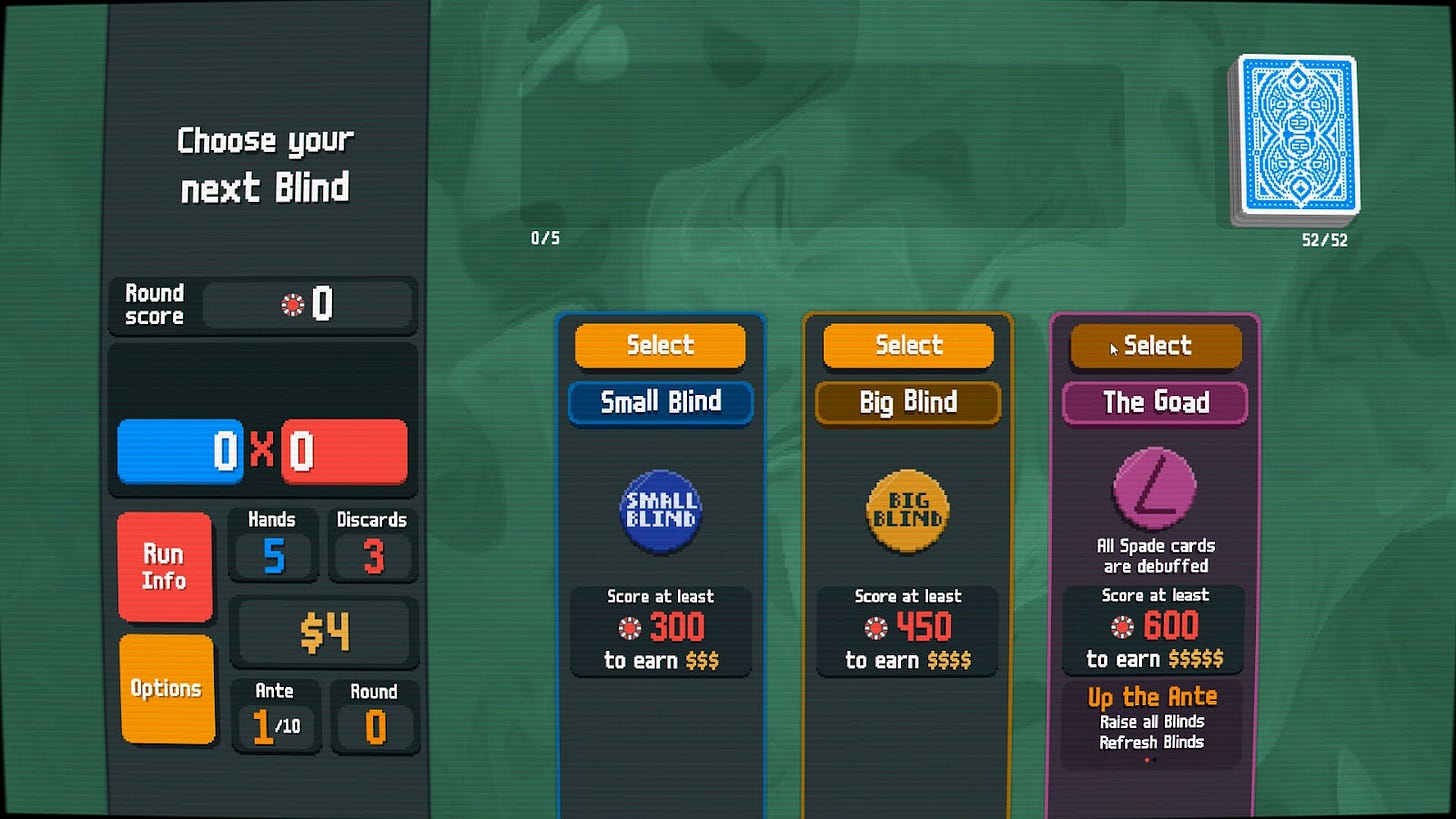High Card Rush (Balatro Review)
Try your hand at poker with a twist in Balatro, a new indie rogue-like deck-builder with an addictive gameplay loop.
Written by Tpage (@tpagetenor)
At last, you’ve reached the final boss. Your palms start sweating, and you’re counting your lucky stars that you made it through the past few fights. This ultimate hurdle seems almost insurmountable, the demand so much greater than anything prior. You frantically shuffle through your inventory, discarding every unhelpful bit of junk you’ve gathered until you finally play your master stroke and achieve victory in a single move.
Or, more likely, you’ll realize you flubbed the math somewhere and lose by the slimmest of margins. Then, a smug little playing card will mock you as you ready yourself to try again anew.
Back to School
Actual “combat” in the new rogue-like deck-builder Balatro may not have such epic trappings as the introduction might suggest, but the 5-card poker gameplay is no less enthralling for it. The premise of the game is simple enough at the start. You begin with a standard 52-card deck of playing cards and have a limited number of chances to make traditional poker hands. Similar to their real-world counterparts, hands are worth different amounts of money (or, in this case, chips). Each level sees you facing off against three “Blinds,” which are increasingly high thresholds of chips you must accumulate during your allotted number of playable hands.
Scoring is done through a combination of your hand’s rarity (i.e., a flush is worth more than a pair) and the numerical value of the cards used to play it (Aces are worth 11 chips each, face cards are worth 10, and then on down numerically). The “hand value” multiplies your chip total for that hand, so the simplest example would be a pair of twos. Each two is worth two chips, so you now have a total of four. A pair is worth a 2x multiplier, making the played hand worth eight chips. A pair of Kings, on the other hand, would be worth 20 chips, then multiplied by two for a total of 40 chips. If this sounds like too much math and I’m losing you, I get it, but please hang in there! Understanding this basic formula unlocks a truly fantastic experience.
Breaking the Rules
Where Balatro begins to get its hooks into you is the myriad ways in which you can cheat. The game actively encourages it! When you successfully defeat a Blind, you’re rewarded with cash and taken to a shop where the real deck-building side of the game comes in. The most important modifiers to your run are Jokers, which run the gamut from mundane to outlandishly powerful. By default, you can hold up to five at a time, and with over 150 to discover, there is no shortage of variability. Some effects are simple to understand, such as adding an additional +4 to your multiplier for every Spade played. Other, more powerful Jokers tend to be extremely situational, such as the Campfire, which gains a multiplicative multiplier for each card sold but resets after each boss.
Other shop items allow you to expand or modify your deck. Tarot cards allow you to alter your cards by changing their suit, making them wild, or adding multipliers. Planetary cards level up the value of a particular hand type. The rarest “spectral” cards offer incredibly transformative effects that almost always come with a penalty. Lastly, there are Vouchers, which are permanent passive buffs that improve your run in the long term, such as increasing your cash earned or allowing you to alter the ability of the Boss Blinds.
Your last piece of “equipment” is the deck you choose to start with. At first, you’ll only have access to basic decks with simple abilities, like allowing you more opportunities to play hands at the cost of chances to discard cards or vice versa. As you begin to fulfill certain conditions and win runs with simpler decks, you unlock trick decks that can dictate your entire build. Certain decks might start you with only two suits of cards or no face cards at all.
Just One More Hand
Now with all of this technical stuff out of the way, why the heck is this game so darn addicting? To put it simply, this might be the best distillation of roguelike mechanics I’ve ever experienced. A simple deck of 52 cards has more ways to shuffle it than there are atoms on Earth, and Balatro said, “That’s not enough randomness.” The variability added by the Jokers and the other card modifiers, not to mention that you add additional cards to your deck, means that no run will ever be the same. Oh, and yes, by adding cards, you can indeed create traditionally illegal hands such as a five-of-a-kind or a “Flush House.”
The pace of the game invites rapid repetition like no other (once you’re more comfortable with the mechanics, I recommend bumping the game speed up to maximum), as you can clearly see whether a run is dead in the water fairly early, unlike other legendary roguelikes such as The Binding of Isaac or Slay the Spire where you may end up spending half an hour before realizing victory is simply out of your reach. When you first start out, new items are unlocked rapidly, and everything seems useful. I’ve had runs where my entire strategy has pivoted halfway through because of one card being added to my deck or roster of Jokers.
Of course, as with any roguelike, the specter of RNG can destroy even the most well-laid plans. You might have spent the first six levels designing an unstoppable deck, generating hundreds of thousands of chips from easy-to-play hands. And then the Boss Blind will shuffle your Jokers and utterly destroy the chip-generating equation you’ve spent the last 20 minutes perfecting. Seeing your hard work crumble to dust so quickly can be a real bummer. Yet, it never feels so random as to be unfair. Adaptability is key. You simply cannot go into a Balatro run with a “build” in mind. You must react to the options presented and optimize as best you can. It’s oddly freeing.
Aesthetically, Balatro’s pixel art is charming, with a wide variety of Jokers ranging from traditional clowns to cozy slice-of-life scenes to true abominations. The interface is easy to parse and navigate, although I have heard from colleagues playing on Switch in handheld mode that the text size is quite small. Hopefully, the developers will add some scaling options to improve accessibility there. The soundtrack is a never-ending loop of jazzy, lo-fi synths that never seems to overstay its welcome. Certain decision moments and boss fights will modify the soundtrack to ramp up the tension or enhance the atmosphere. Overall, the game has a distinctly ethereal feeling, which is great when the primary visuals are just playing cards.
I stopped writing this review just to play a few more rounds of Balatro. Those “few more rounds” turned into about three hours. I simply cannot stress how great the gameplay loop is; it sucks you in and effortlessly demands your attention. It’s priced at the Indie sweet spot of $15 USD, and I can honestly say it’s given me more hours of pure entertainment than anything from the AAA sector this year. Don’t be scared off by the math. Just buy it.










Nice review, any chance it will come to iPad?